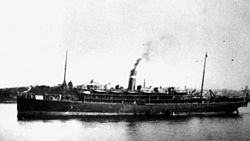Kanowna (ship, 1903)
|
||||||||||||||||||||
|
||||||||||||||||||||
|
||||||||||||||||||||
|
||||||||||||||||||||
|
||||||||||||||||||||
The Kanowna was a passenger ship of the Australian shipping company Australian United Steam Navigation Company put into service in 1903 , which carried passengers, mail and cargo in a regular service between Fremantle on the west coast of Australia and Sydney on the east coast. During the First World War she served the British Admiralty under the name HMAT Kanowna (A61) temporarily as a troop transport and hospital ship . On February 19, 1929, the ship sank on the coast of the state of Victoria after a rock collision. All passengers and crew could be saved.
The ship
The 6,942 GRT, steel- built steamship Kanowna was built on behalf of the Australian shipping company Australian United Steam Navigation Company at the Scottish shipyard William Denny and Brothers in Dumbarton and was launched there on October 21, 1902. Her identical sister ship , the Kyarra (6,953 GRT, hull number 672) was also built by William Denny and was completed a few months later.
Both ships were large and luxurious ocean liners by Australian standards at the time. The Kanowna was 126 meters long, 16 meters wide and had a draft of 8.72 meters. She had a funnel, two masts and two propellers and was powered by two triple expansion steam engines that could accelerate the ship up to 15.3 knots. The steamer, which was designed as a passenger and cargo ship, was able to carry 126 first-class passengers and 160 second-class passengers.
The Kanowna leveled before the war between Sydney ( New South Wales ) and Fremantle in Western Australia . She was registered in Adelaide .
Use in the First World War
On August 8, 1914, the Kanowna was requisitioned by the Australian military as a troop transport and used until September 1914 to bring 1,000 soldiers to German New Guinea as part of the Australian Naval and Military Expeditionary Force . During this time there was an incident of mutiny on board. The captain of the Kanowna radioed the Sydney that the stokers and coal trimmers had stopped working. The Australian Commonwealth Naval Board opened an investigation into the incident, even though the Kanowna, as a civilian ship, did not actually come under their jurisdiction. On September 21, 1914, the Kanovna was returned to its owners.
On June 1, 1915, she was requested again for military service. This time she carried troops and supplies to Egypt . From there she went to England, where she was to be converted for service as a hospital ship. For this purpose, it was able to transport 88 medical staff and 452 patients in addition to its regular crew. From September 1915 she brought troops of the Royal Army Medical Corps (RAMC) to various locations in the Mediterranean and wounded soldiers on the return trips back to Australia. After the declaration of unlimited submarine warfare in February 1917, the Kanovna was forced to circumnavigate Africa instead of steaming through the Mediterranean.
After the end of the war in November 1918, the Kanovna brought around 900 Commonwealth prisoners of war from Turkey . On July 29, 1920 she was returned to her shipping company and returned to the passenger and freight service that she had been in before the war.
Downfall
On Saturday, February 16, 1929 at 12.40 noon, the Kanowna ran under the command of Captain Newberry with 200 passengers on board in Sydney for another crossing to Melbourne. Two days later she ran onto the cliffs of Cleft Island off the Wilsons Promontory peninsula on the coast of the Australian state of Victoria . The passengers were then transferred to the steamship Mackarra . At first it was expected that the wrecked ship could be stranded, but the steam boilers went out after a short time. The crew who remained on board were therefore taken on board by the Dumosa . The ship sank the next morning (February 19).
A court investigating the incident held the captain responsible for the accident as he had failed to reduce the speed of his ship despite the fog.
The Kanowna is one of the largest wrecks on the Victorian coast. The exact location of the wreck was unknown until divers found the remains on April 23, 2005 at a depth of about 80 meters. A closer inspection of the wreck on May 8, 2005 enabled it to be identified.


